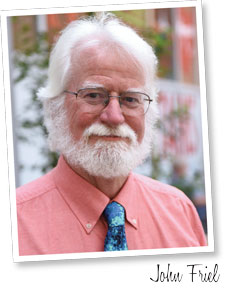11/1/2023
Bridges, Boats & Blooms
John Friel

Lately, I’m musing, gratefully, on two recent cases of blind luck, widely separated, but united, by a common theme: water.
The first case dates back to 2018 when a neighbor had some big trees taken down and asked if I wanted the wood for my stove. Much of it was catalpa, a native with large, lovely flower clusters. It’s often called “cigar tree” for its long beanpods. Unfortunately, it’s pretty lousy firewood.
But one log stood out. Twenty feet long, laser-beam straight, it seemed like a candidate for interesting lumber. And it was free. Another neighbor with a skidsteer carried it to my yard and I got to work on it.
Five years and change later, on October 1, 2023, I launched the strip canoe I’ve wanted to build most of my adult life. It’s catalpa, walnut and ash, all donated by friends, all milled with my chainsaw. Five years sounds like a long time, because it is, but there were extenuating circumstances. Lumber has to season, after all, and there was this weird disease screwing up everything. Most time-consuming of all was settling on a design.
I got lucky in a couple of ways: Catalpa wood proved light, strong and flexible, ideal for a stripper hull. I know of no other such craft; most strip-built canoes and kayaks are made of cedar, but no one offered me a cedar log. Also, most catalpas around here are fairly short and gnarly. This one had grown tall and nearly devoid of knots. The grain is gorgeous; the boat gets rave reviews from everyone who’s seen it. If you doubt that, I can bore you to tears with a PowerPoint show tracking its construction and eventual launch.
Yes, there was champagne. You shoulda been there.
The second case of unexpected good fortune involved a lot less labor and stress, if you don’t count a 12-hour roundtrip drive complete with rain, construction delays and nasty traffic. I have grandkids in Massachusetts. One rainy day, we visited Shelburne Falls, one of those cute/quaint towns one expects in New England, with a picturesque river and waterfall. It did not disappoint.
Much has been written in rightful praise of two high-profile, high-altitude gardens: New York’s famed Highline and Philadelphia’s still-in-process Rail Park. But decades before either project was even a gleam in an urban planner’s eye, Shelburne Falls had the Bridge of Flowers. An abandoned trolley bridge across the Deerfield River, connecting Shelburne Falls and Buckland, was becoming a weed-choked eyesore. In 1927, Mrs. Antoinette Burnham, whose home overlooked the structure, asked, “If weeds can grow on that bridge, why not flowers?”
The local Women’s Club took up the challenge. The weeds came out, many loads of loam, fertilizer and flowers went in, and by 1929 the eyesore was an attraction. As it turned out, flowers do just fine there, drawing 100,000 visitors per year. Kudos to the army of volunteers, especially the local Women’s Club, who maintain it.
The signature species seemed to be dahlia, in a multitude of hues and sizes. There’s even a Red Dahlia Cafe at one end. But there were pleasant hardy surprises, like hakonechloa, cotinus, tricyrtis and a venerable wisteria with a trunk whose girth approached that of a slender human torso.
The Bridge of Flowers discovery was lucky in a couple of ways. First, simply because of its serendipitous, lovely presence. We were in town to visit a trolley museum and take a brief ride on a restored trolley of the type that used to trundle across the bridge early in the 20th century. Visiting the bridge itself was an afterthought. I’d never heard of the thing and suddenly there it was.
The second piece of luck: It’s about to close until 2025. The span and the water main it carries both need maintenance. The last overhaul and closure occurred in 1983-84. Had the rain not let up, had I visited next month or next year, that very pleasant stroll would not have happened.
A trolley bridge isn’t an intuitive place to create a public garden. Catalpa isn’t a first-choice species for a canoe. But both work beautifully.
Keep your eyes and mind open. You might get lucky. GP
John Friel is a freelance writer with more than 40 years of experience in horticulture.